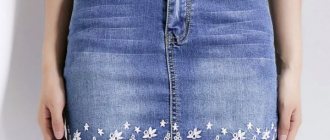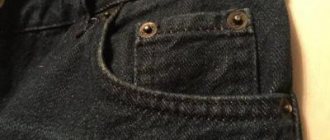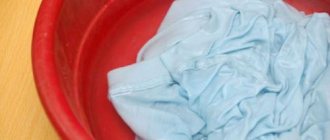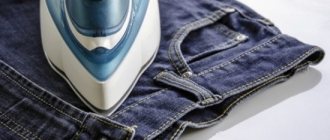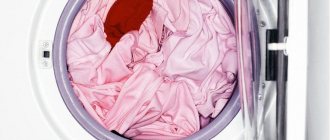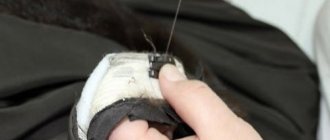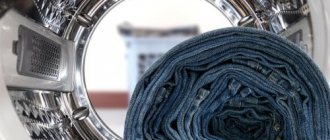Ideal jeans hide flaws, emphasizing the advantages of the figure. It happens that a person searched for a long time for a suitable pair for him, found it, and it fit him like a glove. Naturally, he will acquire this thing. Fitting takes 5–10 minutes. When a customer wears it throughout the day, they may end up with an unpleasant surprise - blue legs or stained underwear. The reason is that the jeans are dyed, what to do in such a situation? The problem is not new and there are a number of actions that will help avoid such embarrassment in the future.
How to check before buying whether jeans are dyed
You can check whether jeans are dyed right in the store using a damp cloth.
First, we should debunk the myth that if jeans are dyed, then they are of low quality. This is wrong. A tendency to “shed” is a sign that the material was painted using natural dyes. For this reason, expensive products from world brands often leave marks on the body and clothes during the first time after their purchase.
How do you know if the material will fade? You can do a short test right in the store fitting room. Take a piece of light fabric, preferably natural (a handkerchief will do), lightly moisten it and rub the surface of the jeans. If blue marks appear on the scarf, this indicates that the dyeing composition will leave marks on the skin and underwear during wear.
Recovery options
As soon as it becomes clear that the jeans have turned a different color, you need to act. You can’t hesitate - you need to avoid complete drying of the product and quickly soak your pants with Vanish OXI. This product will not allow foreign dye to attach to the fabric without harming the main pigment, thanks to a specially selected composition. Using the cleaner is simple: dilute it in a basin according to the instructions on the package, and dip the stained clothes into the resulting solution. If the first wash does not help, you should repeat the procedure several times.
A special universal anti-staining agent “Vanish OXI” will help get rid of foreign paint.
When the effects of molting are detected on dried things, “Vanish OXI” and other similar products are powerless. After drying, the foreign pigment penetrates deeply into the fabric, and it can only be removed with the original paint, which will lead to discoloration of the item. Therefore, most housewives “write off” faded jeans, throw them away or use them as country trash. But it’s better not to devalue clothes, but to try to bring them back to life in the following ways:
- re-dye jeans using dry cleaning (an inexpensive technology that allows you to evenly cover light fabric with black or blue dye);
- dyeing the jeans yourself (an extremely risky option, since it’s unlikely that you’ll be able to dye your pants evenly);
- hide traces of shedding with decorative elements and cuts.
The last method will require creativity. For example, many paint stains are hidden behind decorative embroidery, special stickers and patches. Perfectly hides streaks, cuts and abrasions. If everything is done beautifully and tastefully, then old damaged jeans will become fashionable designer items. But it is better to resort to such measures when it is no longer possible to remove the foreign pigment.
Jeans are fading. What to do?
Before washing jeans, you need to turn them inside out and check the pockets.
The answer to the question of when will jeans stop fading is very simple: as soon as the excess, unabsorbed dye is “washed” out of the fabric fibers. You can speed up this process by simply washing your pants properly.
To prevent jeans from staining or fading, washing is carried out in several stages in compliance with certain rules. The sequence of actions looks like this:
- Preparing clothes. At this stage, you need to check your trouser pockets, remove all contents from them and remove the belt.
- Pre-soaking. To prevent richly colored material from staining your skin and linen, it is imperative to soak your trousers before washing. Use only warm water (high temperatures are not needed in this case) and leave the item to soak for no more than 40–50 minutes.
- Hand or machine wash. It will be better if you wash your pants by hand. This will protect the fabric from the aggressive effects of machine washing. If you still decide not to waste time “fussing around” in soapy water, set the “delicate mode”.
Jeans should be soaked for an hour before machine washing.
If you are not too lazy to wash your trousers by hand, drain the water in which they were soaked and prepare a solution of warm water and washing powder.
You can use laundry soap.
How to bleach a white collar on a black dress at home?
Many women have a classic standard in their wardrobe - the little black dress. It can be with a white collar, decorated with beautiful embroidery or elegant white lace. But when washing such things, you need to be extremely careful so that the white color is not spoiled. But if trouble does happen, then you can find out below how to bleach a white collar on your black dress.
Questions often arise about how to wash a white collar on a favorite black dress, since collars can turn yellow from contact with human skin and the influence of sweat on them. To whiten them, you can use hydrogen peroxide. For this:
- moisten a cotton pad with peroxide;
- apply a moistened swab to the stain, leaving it for 5-10 minutes;
- wash the item in any way.
How to properly wash black items with white items
To properly bleach products, it is best to do this manually. Here is a small instruction, the implementation of which in a given sequence can help restore the beauty of your favorite outfit:
- pour warm (not higher than 30°C) water into a basin or large bowl, dissolve any liquid laundry detergent (gel, for example) in it;
- Soak the damaged product in this solution for about an hour, then rinse well;
- After drying the rinsed item, you can begin to whiten the stains that have appeared;
- lay the dress out on a flat surface, carefully moisten all necessary areas with the bleaching solution;
- After some time, rinse the product thoroughly in water.
It is better to wash this item by hand
Attention! To wash such outfits, it is better to use washing gels rather than powders, which themselves can leave whitish stains on black fabric. Also carefully check your laundry detergents for the presence of bleaching ingredients.
Drying Features
It is important not only to wash any item, but also to dry it properly. Drying jeans is carried out according to the following rules:
- after washing and rinsing, the item should be gently wrung out; the material should not be twisted with force (this will damage the fibers and deform the clothing);
- You need to dry clothes by first turning them inside out;
- Jeans must be hung by attaching them to a rope in the waist area.
In addition, the best option for drying is to find the item in the fresh air. You should not lay clothes on a radiator or hang them over a heater.
Is it possible to iron jeans? Most models are designed in such a way that the item fits tightly around the hips and legs. In this case, ironing will be unnecessary.
Jeans should be ironed according to the instructions on the tag.
If you purchased looser-fitting trousers, you can iron them by selecting the appropriate temperature setting for the material.
How to return color to different types of fabric?
Depending on the type of fabric, priority bleaching methods will differ:
Cotton and linen items are not afraid of high temperatures, so they can be boiled. They are resistant to various types of bleaches, including chlorine. However, exposure time should be kept to a minimum.- Synthetic underwear is durable and wear-resistant, but does not tolerate contact with aggressive agents.
Therefore, preference should be given to gentle bleaches and folk remedies. You can use aspirin, laundry soap, lemon juice, soda, and ammonia. The maximum water temperature is 60 degrees. - Printed items should not be soaked in caustic substances. If such fabric has faded, then it must be handled carefully, trying not to get on the printed image.
- Snow-white satin should be washed in warm water (up to 40 degrees). It is not recommended to rub the fabric. The best bleaching agent is vinegar or oxygen stain remover.
- Woolen fabrics are treated only with liquid stain removers.
The more delicate the fabric, the more gentle the bleaching agents should be.
What to do if jeans are dyed? We fix the paint on the fabric
To fix the dye on jeans and prevent excessive “washing out” of the color, you can use improvised means.
Table vinegar for rinsing
Rinsing is necessary to remove any remaining detergent or other detergents from the fibers. But in the process of rinsing jeans, you can not only remove chemicals from the fabric, but also fix the dye. You need to do the following:
- Lay the trousers at the bottom of the bathtub and, turning on the shower, rinse the item under the running stream.
- Dilute a few tablespoons of 9% vinegar in a bowl of warm water.
- Place clothes in the container for 10–15 minutes.
After this, you will need to carefully wring out the material and hang the item on a rope, carefully straightening out the folds.
Salt "baths"
Salt fixes the dye used to process denim material well, without damaging the fibers of the fabric. The mechanism of action in this case will be the same as when rinsing in vinegar.
For a salt “bath”, the solution is prepared in the proportion of ½ cup of salt per 5 liters of warm water. You can place the item in a container with a “fixer” after the salt has dissolved.
It should be borne in mind that the measures listed may not give results after the first wash, and you will have to repeat the manipulations several times.
Adviсe
In order to maintain the quality and beautiful color of jeans, you should not use aggressive washing powder containing bleaching components. You should not wear things and rub them with a brush, squeeze them hard, and even more so, twist them. Add a little table vinegar to the last rinse water. This will not only prevent color loss, but also refresh it, make it brighter and more attractive.
Jeans and skirts are dried in a straightened form, hanging from the belt with clothespins, shirts, jackets and dresses - on hangers, after allowing the water to drain. Clothes should be protected from direct sunlight and hung to dry in the shade.
If the rules are followed, denim will serve for a long time, gradually acquiring noble wear and softness.
When washing, the jeans got stained from other laundry. What to do?
Many people advise washing jeans separately from other clothes to prevent shedding. If only one trouser made from this fabric needs washing and there is no time to wash them by hand, housewives have to put the trousers in the drum along with clothes from other fabrics.
As a result, there is a risk of things coloring from each other. What to do in this case? How to save your favorite jeans if they are stained from other clothes? There are proven methods.
Stain removers and bleaches
In stores you will find a huge selection of stain removal products. In order to put the thing in order, you will need to strictly follow the instructions, and the problem will be solved.
When choosing a stain remover, make sure that it is suitable for treating denim. And when using bleach, be careful and only use it on very light-colored pants. Otherwise, in place of the stain you will find a faded area of fabric.
Laundry soap
Despite the presence of a huge range of chemicals, laundry soap occupies a leading place among means for combating stains on fabric.
Wet the stained area under warm water and lather it generously. After a few hours, wash the item by hand or in the washing machine.
Lemon
Lemon can only be used on light-colored fabrics.
Cut the citrus fruit in half and rub the stain generously with half a lemon. Leave the item for 2-3 hours, then wash with laundry soap or washing powder.
You should be aware that lemon juice can greatly lighten fabric fibers, so use this method only for light-colored fabrics.
Ammonia or peroxide
You can also use this method to remove stains from colored fabrics, but the effect will only be if the item has not yet dried after washing.
Prepare a solution in the proportion of 20 g of peroxide or ammonia per 5 liters of water. Place the soiled items in the container and leave for 30–40 minutes. If the fabric from which your jeans are made is quite thick and light, you can boil the item in the solution for 20–30 minutes.
After this, the clothes are thoroughly rinsed and sent to dry.
A mixture of potassium permanganate and washing powder
This product is used for severe stains as an aggressive method of combating stains.
Add 5-7 potassium permanganate crystals to the powder solution, wait until they are completely dissolved and soak the laundry in the resulting product for 20 minutes. Then rinse the item under strong water pressure and put it in the washing machine.
Pre-washing new jeans
A light wash with one of the color fixers will help remove excess pigment from the fabric of new jeans:
- table salt (10 tbsp per 10 l);
- 9% vinegar (100 ml per 10 l);
- 70% vinegar essence (1 tbsp per 10 l);
- lemon juice (3 tbsp per 10 l).
The procedure is carried out as follows:
- Take a large plastic basin. It is better not to use a bathtub when washing for the first time. The dye can settle firmly on the enamel, and it will be problematic to wash it off.
- The container is filled with cool water. Dissolve the selected color fixer in it. Temperature is of great importance: the higher it is, the more pigment your faded jeans will lose.
- The inverted model is immersed in the solution for half an hour. It is better not to increase the soaking time. Long-term contact with fixatives causes the fittings to fade and the structure of the fabric, especially stretch, to deteriorate.
- When the specified time has passed, the jeans are lightly wrung out and transferred to an empty container, and then dried.
Usually this treatment is sufficient for the first time. Although, in order to finally fix the color, the procedure will have to be repeated 3-4 more times, reducing the concentration of the fixative by half.
During the first month, it is recommended to wear new jeans only with dark clothes, and also not to wear them in the heat or during rain.
Alternative to whitening
If things are dyed during washing and when restored there is a risk of ruining them with home remedies, then it is best to go to dry cleaning. Perhaps they will find an effective method for resuscitating damaged tissue. However, you can approach the solution to the problem that has arisen creatively, using design ingenuity:
- Armed with a stencil, sponges and paints, apply the design you like to the stains.
- If you feel confident in the role of an artist, an original pattern can be applied without additional equipment, using a can of acrylic paint intended for painting on fabric. The pattern will dry quickly and will not blur during washing.
- Items made from cotton material can be boiled in aniline dye, giving them a new color if desired.
- Adherents of a bright style will like the applique, which can be used to easily disguise the resulting stain. You can also use sequins and even rhinestones to hide the color and get a bold design solution.
Faded items should not be thrown away until all methods of resuscitation have been tried. Both active chemicals and familiar home remedies are suitable for this. As a last resort, you can seek help from a dry cleaner or disguise the resulting stains with hand appliqué and design.
It is also important to remember that synthetic items are much more difficult to “save” than cotton clothes, so you should approach them with extreme care.
photo: depositphotos.com/Amaviael, banprik
Will there be a specific smell left?
Many people are confused by the strong smell of vinegar. Therefore, they do not dare try the method - they are afraid that it will “saturate” the denim fabric so that they will then be embarrassed to appear in public. However, experts, as well as people who have used the old advice, note that the specific smell quickly dissipates. Especially if you dry your jeans in the wind (near an open window, on the balcony or on the street).
It is also important to add: you should not treat jeans with a vinegar solution in an enamel bath, so that marks and stains do not remain on the snow-white surface, which will be difficult to clean later.
General recommendations
To begin with, I would like to give some tips on choosing and caring for clothes or shoes:
- When choosing a new outfit, wipe the item with a damp cloth, and if traces of paint remain on it, it is better to choose another company.
- Always strictly follow the instructions on the label.
- It is prohibited to treat dyed fabrics with soda solution.
To prevent fabric from dyeing, use products such as:
- Salt.
- Acetic acid.
- Powder for hand washing.
- Turpentine.
- Glycerol.
- Wipes for washing.
To avoid shedding during washing, we recommend using special washing cloths. These anti-dye wipes help protect fabrics from fading or fading, catch hair and fur, and keep different colored items from staining during washing. They are suitable for both hand and mechanical washing. The main advantages of napkins:
- Prevents fading of fabrics;
- Improves the quality of washing;
- Save time, detergents and electricity;
- You don't have to sort your laundry before washing;
- Suitable for all types of fabrics;
- Suitable for hand and machine wash;
- Collect hair and wool;
- Prevents the appearance of gray and yellowness on things;
- Effective at any temperature.
On the website of the MPF napkins manufacturer you can order and try the napkins at home for free. Free delivery throughout Russia


